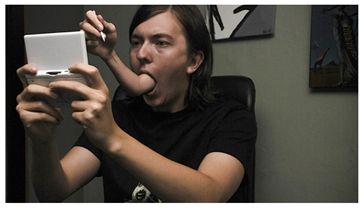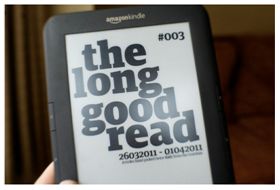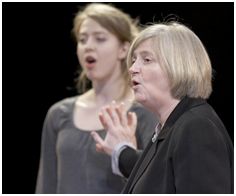![]()
You are welcome to share your thoughts on this article written by Greg Taylor, Director of Brand Provocation at Elmwood, London
A colleague of mine, Laura, recently thrust a copy of the Stylist magazine in front of me and suggested I read a piece on Arianna Huffington, of Huffpost fame. Nothing surprising in that—Laura is a go-ahead lady, and as well as being our writing director, is a published poet—and I assumed it would be one of those inspiring stories about someone building something out of nothing and changing the world in the process! What I discovered was altogether more disturbing. It turns out that Arianna had a life-changing moment, all because she multi-tasked so hard that one day she fainted from exhaustion, smacked her head on her desk, broke her cheekbone, and needed five stitches in her eye. This wake-up call got me thinking—so much of what is supposed to make our lives easier, richer, and more exciting in fact may do the opposite. Yes, we’re connected 24/7 but are we truly connected to who and what we’re doing, when we’re doing it? Yes, we can do lots of things at once but is it a case of quantity over quality? And yes, we need stimulation to make life interesting, but how we let our minds wander needs to be more focused. All this, if left unchecked, could mean that ‘connectivity’ will eventually become oxymoronic.
Just do it (more)
We’re all guilty of it . . . multi-tasking. Clicking through emails whilst we’re watching the news, checking Facebook or tweeting whilst we grab a sandwich. Even when we’re having a face-to-face conversation, we have half an eye on our email. The Blackberry wasn’t nicknamed the crackberry for nothing. We’ve become addicted to multi-tasking because it seemingly makes us feel in demand. We’re switched on and needed. Or it makes us feel in control—we’re responsive and on top of things. Or it makes us feel productive—we’re doing lots of stuff and making things happen.
However scientific studies are revealing another picture. According to Professor Earl Miller, a neuroscientist at the world-renowned Massachusetts Institute of Technology, our brains are wired to focus on one task at time. Miller carried out a study whereby he scanned volunteers’ heads while they performed different tasks. He found that when there was a lot of visual objects in front of volunteers, only one or two objects tended to activate the brain. This means that the volunteers could only focus on one or two objects at any given time.
This issue is something that technology superbrands like Apple and Microsoft appear to be wrestling with at the moment as they combine influences from mobile operating systems alongside the more conventional desktop. OS X Lion has touch interaction and full screen apps, the purpose we assume is to support the kind of unitasking we do on our iPhones. Lion allows any app to be launched full screen and whilst this blocks out distractions it does mean that users have to continually switch applications. Microsoft, on the other hand, has plans for Windows 8 to introduce Windows Snap, a feature that allows apps to be viewed side-by-side. The long-term challenges that will need ironing out are likely to be around how an OS system designed for one hardware format successfully translates into one it wasn’t originally intended for.
Another school of thought looks to the success of devices like Amazon’s Kindle. Even though Apple and co are looking for ways to help us do one task at a time, their devices still do multi-task. The Kindle takes people in the opposite direction, as it attempts to aid our ability to concentrate. It is designed to do just one thing well and that’s read. It can do other things, but their functionality’s not all that good, which means ultimately you just use it for reading. It might have been unintentional but the Kindle looks like it’s tapped into people’s craving for help in narrowing their focus.
No browsing, no milk
For those of us involved in the creative industry, the idea of ‘narrowing’ presents a bit of a dilemma. As the adage goes, ‘it is for the creative as it is for the cow—no grazing, no milk’. After all, aren’t we meant to wander free looking for the random stuff that’s going to help us be more creative? Perhaps the answer lies somewhere within the basic principles behind all creative thinking tools, which according to writer Paul Plsek, are attention, escape, and movement. So focus your attention on the issue, then escape the way you traditionally think, and finally suspend judgment and allowing your imagination to explore different possibilities.
Sure, it’s useful to be able to multitask as South Korean commuters can with Home Plus, the virtual store on subway platforms that allows them to shop while waiting for the train. Ultimately, though, we need to take control back from the distracting nature of technology and be in charge of our brains, creative or otherwise. We need to be more self-aware about how we use technology, and be mindful of how it impacts not just on the quality of our thinking but also the quality of our communication.
One way to achieve this focus or narrowing is to adopt Deepak Chopra’s idea of ‘present moment awareness’. Chopra is a world-renowned authority on mind-body healing and recommends that to be successful at what you do you should neither spend your time constantly in either the future or the past but rather in the present. Be fully absorbed and committed to what you are doing NOW. It’s common sense really. If you do things with 50% of your mind on the task at hand and 50% somewhere else, you are less likely to get the result you want. So next time you’re in a meeting, on the phone or working on a project, try just totally immersing yourself in that moment. Give all your attention to the person, the conversation, the task.
Second circle
But what else can we do to improve the quality of our communication? A good place to start is with that most fundamental of communication tools, the voice. Which is why it’s worth listening to the thoughts of Patsy Rodenburg, Director of Voice at the Guildhall School of Music and Drama. Rodenburg has worked regularly with the likes of Ian McKellen, Ralph Fiennes and Nicole Kidman, and is passionate about the potential of the voice. «The voice encompasses so many things,» she says. «Everyone comes on to the planet with a fantastic voice, but people lose it. The voice is about communicating, engaging, how you show yourself, how you speak, how you listen.»
Rodenburg’s theory for how you do this is explained in her books Second Circle and Presence. Essentially there are three circles of energy. The first is where a person withdraws into the self. The opposite is the third circle, the loud and boorish. The second circle is the ideal state, where a person’s energy is focused. In the second circle she explains your energy «moves out towards the object of your attention, touches it then receives energy back from it.» She goes on: «You are living a two-way street—you reach out and touch an energy outside your own, then receive energy back”.
This is how you really make a connection with the people and things around you and if you’re to withstand the barrage of distraction that technology will continue to throw at you pause for a moment and step into second circle.
Alternatively, you could always sing along to Simon and Garfunkel’s 59th Bridge Street and start feelin’ groovy.
About the Author

Greg Taylor became founding partner in global brand design consultancy Elmwood in 1989. Now Director of Brand Provocation, Greg is the creator and facilitator of Step Change™, Elmwood’s strategic tool for moving ideas forward. Clients include ASDA, Wal-Mart, Arla Foods, BBC, COI (Defra and DfT), Cable&Wireless, Comic Relief, Debbie & Andrew’s, Durex, Glasgow 2014 Commonwealth Games, McCain, and the Met Office.




